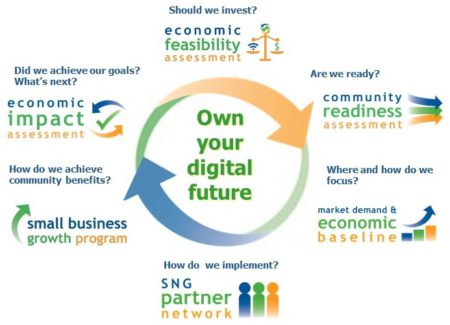Invest in Digital Infrastructure, not Just Broadband Networks
 There are still far too many communities without broadband and funding agencies do not have enough money to fund all of the necessary digital infrastructure and last mile connectivity to individual premises. It is time to start looking at different ways to deploy broadband into unserved and underserved areas.
There are still far too many communities without broadband and funding agencies do not have enough money to fund all of the necessary digital infrastructure and last mile connectivity to individual premises. It is time to start looking at different ways to deploy broadband into unserved and underserved areas.
How can funding agencies get ten times more broadband coverage per tax dollar invested?
Localities without broadband will lose residents, businesses, and their tax base. How many communities exist today without roads, electricity, or water and sewer systems? However, areas remain unserved or underserved because there is not enough of a return (profit) for broadband service providers to justify the investment. Whether private, public, or private-public partnerships fund broadband, investments will need to be made and financed for such localities to survive, let alone thrive. A pivot in approach is needed to approach broadband as digital infrastructure.
Current Investment Challenges with Broadband Planning and Investment
- Unserved and underserved areas exist because there is not enough of a business case (profit) for private sector providers to invest
- Many of the unserved or underserved localities have limited resources (financial and staffing) and expertise to develop comprehensive broadband plans that are economically sustainable
- Inertia and gridlock that leads to accepting the status quo after spending time and money on traditional feasibility studies that are fundamentally flawed in trying to make a private sector business case for broadband where none exists.
Broadband Funding Program Challenges
When broadband funding is available, how can funding agencies determine whether:

- Community leaders are staffed and prepared to develop and launch a sustainable solution? In other words, are they committed and ready?
- The project is comprehensive and sustainable
- Potential project risks can be identified to avoid pitfalls, or unsustainable networks that do not resolve the lack of broadband access
- Public funds invested will generate the greatest local economic impacts and community benefits
Digital Infrastructure
Broadband, like roads, is essential infrastructure. Retaining businesses, jobs, and population are all benefits that broadband enables for a locality, but are off-balance sheet to private sector providers. That is why broadband needs to be approached as digital infrastructure – it has become an essential service. Governments invest in infrastructure because there are public benefits that private sector entities cannot monetize – these are externalities, or what we at SNG also call community benefits.
Economic and community development agencies know they must address broadband gaps if their localities are to remain viable. For example, despite fiscal constraints and resistance to public investment in broadband by vested interests, States are allocating $10million, $20million or $100 million to broadband, which are significant legislative wins. However, if the cost to expand broadband to unserved areas is $1.3 to $1.7 billion (as was with the State of Tennessee), it will take at least a decade if reliant upon state funding at those levels – and no community can afford to wait five to ten years for broadband. Anyone that can leave, will have left for better education, healthcare, public safety, economic opportunities, and overall quality of life. Businesses and high value individuals will be very difficult to retain, let alone attract. Struggling localities will continue an accelerating downward spiral.
In the absence of funding private sector investment, municipalities have tried to establish a municipal or utility-based ISP, taking on a bad business case while directly competing with incumbents. Often these projects are locked into the traditional mindset of building a municipal retail ISP as “The” solution. Some have been successful, most have struggled. In many States municipalities are prohibited or severely restricted in taking this retail ISP services approach.
Another approach is funding projects using private service providers to deploy to unserved areas, typically with matching funding. Preference is given to those projects that offer the greatest matching funding to State dollars. This may be straightforward and may ‘check the box’ for broadband service, but choosing one provider to build-out to an area is essentially using public funds to subsidize one provider among many. While it may be compelling for practical reasons, this approach assumes that private providers can and will execute quickly with deployments, as well as provide competitive levels of service to address local broadband demand – current and future. However, subsidizing one service provider in a market tilts the playing field and inhibits healthy competition. Furthermore, problems can arise when profit-driven service providers interests do not align with a locality’s interests and needs – such as deploying smart community services.
Without other options, localities will continue to see under-investment in digital infrastructure even when community benefits outweigh private sector returns on investment.
Investing in Digital Infrastructure Planning
A more recent strategy is investing in digital infrastructure planning which enables funding agencies to leverage ten times what they are currently receiving from their broadband investments. The ten-fold (10x) difference is funding a network build (e.g. $1M for Ammon, Idaho) versus investing in planning to self-finance digital infrastructure (e.g. $100K). Funding agencies can get greater leverage from their broadband investment dollars by helping communities take the right action to invest in their own digital infrastructure than they do by investing directly in that infrastructure themselves.
 The challenge with developing a Digital Infrastructure Strategy for Communities and Regions is that they need help in understanding how this model can work and they need technical assistance to take initial steps. The starting point is assessing potential municipal cost reductions, subscriber savings, local economic growth, and smart community service benefits. When these community benefits outweigh digital infrastructure costs, it is possible to self-finance. For example, when telecom and internet costs can be reduced by 86% (see economic case of Ammon, Idaho) those municipal cost reductions are existing budgets that can be reallocated to finance the digital infrastructure investment.
The challenge with developing a Digital Infrastructure Strategy for Communities and Regions is that they need help in understanding how this model can work and they need technical assistance to take initial steps. The starting point is assessing potential municipal cost reductions, subscriber savings, local economic growth, and smart community service benefits. When these community benefits outweigh digital infrastructure costs, it is possible to self-finance. For example, when telecom and internet costs can be reduced by 86% (see economic case of Ammon, Idaho) those municipal cost reductions are existing budgets that can be reallocated to finance the digital infrastructure investment.
Funding agencies can play a critical role in broadband funding and policies. They can invest in communities rather than a network build. Broadband and digital infrastructure are not ends in themselves, but means to enable good-paying local jobs, grow local economic opportunities, and enhance local quality of life.
What can funding agencies do? A pragmatic, evidence-based approach is needed to make important decisions on broadband funding awards, while minimizing additional work for localities. Furthermore, with uncertainty on the level of broadband funding that will be available, an arms-length, objective process to assess and rank potential projects is needed to:
- Prioritize where funding should be invested for projects that are essentially ‘ready to go’ because they can be self-financed based on economic feasibility and community returns on investment (retaining and growing local business and jobs, access to health and educational services, etc.). These projects would get help with planning, getting started, and implementing a digital infrastructure approach – which is a more efficient use of State dollars when planning costs one-tenth as compared to directly investing in infrastructure.
- More efficient use of public dollars by investing in planning and demand aggregation enables areas to self-finance their digital infrastructure allows the remaining available public dollars to be allocated to areas that have the greatest need, but who may not have the means to address their needs themselves.
- Determine how funding be more efficiently and effectively spent (infrastructure, technical support, demand aggregation, etc.) based on each area’s identified needs, thereby maximizing community benefits per State dollar invested.
A funding agency’s role is most valuable in helping achieve economic and community development goals, while ensuring communities are ready and have the means to implement sustainable digital infrastructure plans.
Maximizing community benefits per broadband dollar invested
How can funding agencies determine where, when, and how to invest to address digital infrastructure needs of communities?
The first step is for communities to answer the question: Do the community benefits from a digital infrastructure investment outweigh the costs for the community/region?
Based on SNG’s long track record and unique experience in working with funding agencies in this way, we recommend the following:
- Assess Economic Feasibility of broadband infrastructure and whether potential community benefits outweigh costs over longer term (e.g. 15-20 years)
- Create a process for communities to self-opt in by providing a standardized input form localities can complete and provide the necessary information
- Those communities that have provided their information will receive an assessment of economic feasibility for their community or region – an arms-length assessment to support their broadband planning. Additionally the localities will have a geographically based phased plan based on estimated demand — to ensure their broadband planning is demand driven.
Outcome from Assessing Economic Feasibility: The funding agency will have an assessment of potential returns from broadband investment for each community / region, which can be ranked in terms of cost-benefit ratios and project sustainability. Additionally, identified municipal cost reductions can be used as matching funds for grant applications. See example of job and business impacts assessed for Custer County, Colorado.
- For communities that have participated in the economic feasibility assessment and their proposed projects prove to be sustainable, invite local leadership (council, broadband committees, etc.) to take the Community Readiness for a Digital Future
- Leadership teams from each community / region take 10-15 minutes to complete an online survey with objective metrics to assess whether or not they are doing the right things needed to get their project across the finish line. It also uncovers different perspectives between stakeholders – is there alignment, or are there gaps in their perspectives and/or approach? Time, money, and political capital can be saved by uncovering and addressing previously unseen gaps.
Outcome from Assessing Readiness: The funding agency receives a readiness summary of communities and regions who may require broadband funding. This enables the State to have a clear picture of which projects are ‘ready to go’ and which projects may require more preparation and technical support, which can be accompanied with broadband funding.
- Based on Economic Feasibility and Readiness findings, prepare a summative ranked list on impacts (increases in GDP, business and job growth, etc.) from State broadband investment dollars with details incorporated on the Readiness of each project – and if needed, how they can be helped to become ready and develop sustainable projects. This is critical input to the success of any broadband planning process at a community and regional level.
An implicit outcome of the steps described above is that communities will reveal their level of interest and commitment to act through their participation. While funding agencies can assist communities, it is essential that the local leaders are willing and able to take action. Funding agencies will know:

- Which communities have the greatest need for assistance
- What type of assistance they need
- How motivated they are to take action on their own behalf
- How ready they are to take action
- What next steps will be most effective for communities ready for assistance
Every community has different characteristics and faces different challenges. Those with the most need may not provide the greatest impact at a State level, but the benefits and impacts at a local level can be a matter of survival for a community or region. With relatively small investments the state can assist such communities to own their digital future and, collectively, the impact on the State can generate significant economic impacts without impractical and limited investments in the broadband networks themselves.



 (Read the
(Read the 

